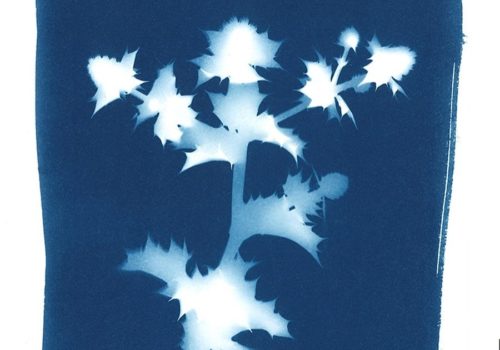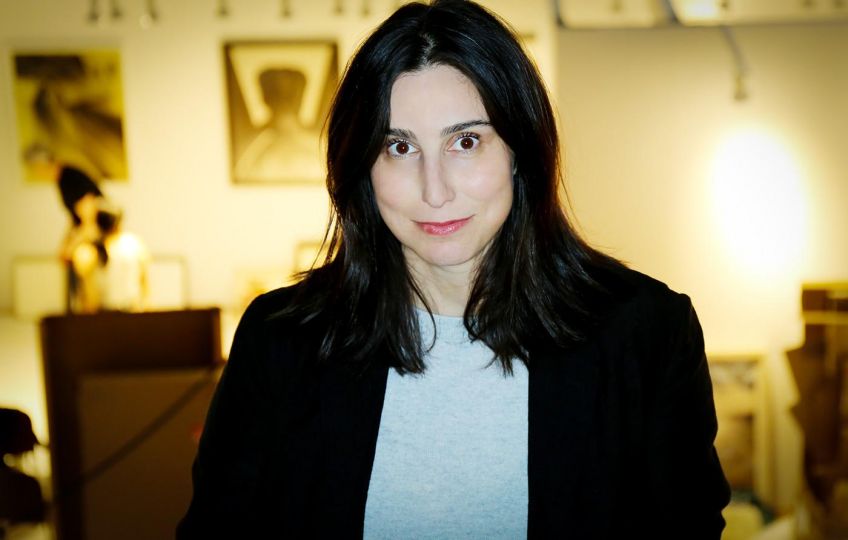Atlas, Herbaria and Rituals: behind this surprising exhibition, hides a collective: the C3 Collective. It is made up of three apprentice botanists and apprentice cyanotypists. One of them Luc Douzon presents these images as follows:
The cyanotype is the result of research on Prussian blue carried out in the 18th and 19th centuries across Europe by various chemists. They allowed in 1847 the development of a photosensitive process by the Englishman Sir John Frederick William Herschel. This involves separately diluting green ammoniacal iron citrate and potassium ferricyanide in water, mixing them in equal parts and then laying them on paper. After drying, a support is obtained with a layer of solution sensitive to ultraviolet rays. The imprint of a plant is obtained by positioning it on the paper and exposing it to the sun. After immersion in water, the shaded parts are white, the exposed parts are blue. A cyanotype is thus obtained.
I started to really take an interest in the process in the fall of 2018. The idea of easily producing plant cyanotypes appeals to me. Prussian blue is striking and sometimes tends towards ultramarine or even Klein blue. At the beginning of October, I acquired the necessary products and I did my first test outdoors. From a discussion with friends, the C3 project was born, the project to collectively make cyanotypes of threatened and protected plants in the Camargue. Inspired by the first cyanotypes produced, the inventory of the algae of the British Isles by Anna Atkins, daughter of a friend of William Herschel.
We quickly discover that, for the realization of the project, there is a set of unavoidable constraints and that each of them is disabling for the others: You have to know where the plants are, the Camargue is much worse than a haystack. ; find them at a graphically interesting point in their life cycle; have time to go to the field at that time; have sun that day.
The list of these plants does not really exist. We are gradually building it by relying on different sources: the National Inventory of Natural Heritage (INPN), Hugo’s advice, the book “Remarkable Plants of Bouches-du-Rhône”, a table of observations in the field and finally access to SILENE, an online database of dated and localized observations, a precious sesame.
You don’t pick the plants, you have to cyanotype them in the field.
We did the first tests in February 2019. We created a device made of a transparent plexiglass, a sheet of photosensitive paper and a rigid cardboard which allows the plant to be pressed against the paper and above all to protect it from the wind, frequent in the Camargue, to have a clear and precise inprint. On the spot, you have to kneel or sit cross-legged and prop everything on your thighs, facing the sun. You have to keep perfectly still. Here too, the slightest movement would cause a blur, an imprecision in the rendering.The exposure to sunlight can last up to 10 minutes.
We use two black pouch to protect the blank and then solarized sheets of paper from unwanted UV. The photographie print are revealed in the water when we return to Arles.
All these constraints impose a slow and sometimes unpredictable pace. We quickly realized that the project would not be completed in a year.
Cyanotypes produced in 2019 and 2020 are on display here.
Luc Douzon
C3 Collective:
Luc Douzon – apprentice botanist, cyanotypist
Hugo Fontès – botanist, apprentice cyanotypist
Arnaud Béchet – apprentice botanist, apprentice cyanotypist
Fontès – botanist, apprentice cyanotypist
Collectif C3 : Atlas, Herbiers et Rituels
From Thursday January 21, 2021
Zoème
Galerie | Librairie | Maison d’édition
8, rue Vian
13006 Marseille
















